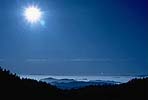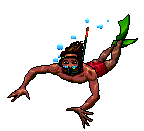

ASPECTS OF EXPLORATION
We shall not cease from exploration.
And the end of all our exploring
Will be to arrive where we started
And know the place for the first time.
T. S. ELIOT
Famous explorers like Jacques-Yves Cousteau,
an underwater pioneer who emerged from
an insightful transformation to a worldwide
crusader for oceans free of contamination,
interjects this fundamental question.
Is what we find there
for us to conquer, master and use,
or is our prime duty to admire and preserve?
How would you like to explore the depths of the sea
on NR-1, a U. S. Navy research submarine?
Nuclear powered, it can stay submerged indefinitely,
with its robotic arm protruding from the bow
and its retractable wheels for ocean bottom mobility.
71 per cent of the earth�s surface
lies beneath our oceans and may well be
the site of the origin of our species.
It is almost the year 2000
and we spend our time, energy and resources
probing the moons of Jupiter
while most of the ocean floor
remains neglected and totally unexplored.
Most scuba divers and marine archaeologists
are limited to 200 feet, yet 97 per cent
of the ocean floor is well below that limitation.
Where shallow-water ship wrecks have been
looted already, the thousands of ships
in extraordinarily deep water are pristine.
Exploration is still an epic journey.
To dream,
to prepare yourself,
to assemble your team,
to go forth to be tested
both mentally and physically
is to pass the test, to find the truth
and come back to share the new wisdom
that exceeds human understanding
and our aptitudes for comprehension.
Everyone is an explorer.
How can we possibly live our lives
looking at a door
and not going forward to open it?
A thousand years ago
the societies of western civilization
lived in mutual ignorance of one another.
The unknown and the forbidden
were thought to be pretty much the same.
To the north lay the vast
expanses of frozen wasteland,
to the east lay the inscrutable orient,
to the west lay
~the green sea of darkness~
and to the south lay the smoldering
semi-mythical land where, it was said,
men turned permanently black.
It would be five centuries
after the Norseman Leif Eriksson
reached North America circa 1000,
before other Europeans would arrive.
Christendom reconciled profit with piety
just as it had during the Crusades.
Hadn�t God commanded them
to subdue the earth,
and didn�t that include its people
of pagan or differing religious inclination?
It mattered little whether Africans,
Orientals, Arabs, Turks or Native Americans
were killed or enslaved during their conversion,
since it was a small price to pay for eternal life.
From the 15th to the 19th centuries,
diseases brought to the Americas by Europeans
killed at least half, and perhaps,
as much as 95 per cent of the native population.
Geologists, paleontologists and archaeologists
spend their time sifting through layers of time,
looking inside, as it were. It has been said that
the African people lack the very real sense
of their importance on our planet,
and should realize that in its prehistory
that this is where it all began.
The more an archaeologist discovers,
the more they want to know.
Exploration is filling in the blanks!
The quest for knowledge, truth,
scientific fact, origins or just doing
that which has not been done before
is a direct, incisive extension
of the human spirit, and the capabilities
he is privileged to apply to the task.

NASA�s main mission
at the time of the first moonwalk,
was to investigate the problems of flight
and to seek solutions to those problems.
Since the quest of space began we have
accomplished unbelievable leaps of progress
in our reach for the stars.
Select outer space or the depths of our oceans,
whichever you prefer, but keep exploring
and searching for the truth of it all.
Keep searching for a few more answers
to a few more of our limitless questions.


MONSTER BACTERIA DISCOVERED
By Mark Schrope
Discovery On Line
Bacteria large enough
to be seen with the naked eye
has been discovered
deep in ocean sediment
off the coast of Namibia
in South West Africa.
The balloon-shaped bacteria
measure up to 0.75 millimeter in diameter
about the size of the period
at the end of this sentence.
A typical bacterial cell
is about 750 times smaller
making this
the largest bacterium
ever identified.
Heed Shulz, a doctoral student
at the Max Planck Institute
for Marine Microbiology in Germany,
said she knew the first time
she saw the giant bacteria
that it had never been identified.
Heed explained that
she had to convince people
because they didn't quite believe her.
Shulz and an international team
of researchers say genetic tests
confirm that the bacteria
are a new species.
The bacterial cells
are usually found connected
by mucus into strands
that resemble a pearl necklace,
prompting researchers to name them
Thiomargarita Namibiensis
or Sulfur Pearl of Namibia.
Setting these bacteria apart
is an amazing ability
to survive conditions
that would normally
spell instant death.
Like many bacteria,
Thiomargarita breathes nitrate,
which is found mostly in water
above the sediment; however,
unlike all but a few related types
of nitrate-breathing bacteria,
Thiomargarita eats sulfur,
and it has to live down
in the sediment to find it.
Some bacteria can move
up to the sediment's surface
to take a nitrate breath.
Thiomargarita; however,
cannot move.
Instead, when storms stir up sediment,
nitrate is mixed down into it
and the bacteria fill
an internal storage compartment
which takes up
most of the cell's volume,
with nitrate.
They use this compartment
like a scuba tank to survive
for three months or more
without a breath.
Other bacteria
would be dead within a day.
Thiomargarita can also
store sulfur in the cell area
outside the compartment
to use as food
when none is available.
Thiomargarita has to sit there
and take whatever nature gives it,
a whole new adaptive strategy
for microorganisms.
Talk about super survivors . . .


HOW AN INSECT FLIES
By Henry Bortman
Discovery On Line
How do insects stay airborne?
According to a neurobiologist,
it is all a matter of timing:
precisely controlling when
they rotate their wings
during flight.
Scientists have long known
that insects get most of their lift
from the simple back-and-forth motion
of their wings.
Michael Dickinson
of the University of California
claims that he has discovered
a missing piece of the puzzle.
In his studies of flying insects,
Dickinson noticed that
they dedicate a lot of neural machinery
to worrying about when and how fast
and where they rotate their wings,
that led him to wonder
just how wing rotation might affect lift.
Looking closer, Dickinson also saw
that at the end of each stroke,
insects rotate their wings
in preparation for the next.
By precisely timing this rotation,
they can take advantage
of currents in the air
surrounding their wings
to generate extra lift ~
as much as 35 per cent
of the total lift.
To analyze these rotational effects,
Dickinson built a robotic scale model
of fruit fly wings.
Dickinson's robotic wings
were many times larger than
those of an actual fruit fly,
but by immersing the wings
in a tank filled with mineral oil
and by moving them slower
than a fruit fly moves its wings,
he was able precisely to replicate
the fruit-fly aerodynamics.
With a sensor attached
to the base of one wing,
Dickinson measured the forces
on the wing at each point
along its path of motion.
He found that by changing
the precise moment when
the robofly rotated its wings,
he could dramatically
affect the total lift.
Insects also use
wing-rotation timing to steer,
Dickinson explains.
Rotating the left wing
a fraction of a second
earlier than the right
creates more lift on the left side
and causes an insect to turn right.
Charlie Ellington, a zoologist
at the University of Cambridge in England,
calls Dickinson's study
"~ a terrific piece of work ~
the significance is that it explains
a dynamic that previously
was poorly understood."


A TINY BEAST THERE LURKS
A placid river suddenly boils
as thousands of panicked fish
thrash the surface.
Within hours they are dead,
scored by bloody sores!
A billion fish have died this way
in eastern American waters since 1991.
The perpetrators are micrscopic
single-celled animals
with fiendishly complex life cycles!
One of their discoverers,
JoAnn Burkholder
of North Carolina State University,
helped christen the best known
of the little beasts
Pfiesteria piscicida,
which means quite simply
fish killer.
Burkholder thinks
Pfiesteria piscicida
originally fed on bacteria and algae.
Recent farm and development runoff
has poured tons of nutrients into some rivers,
which may have caused the organisms
to shift its feeding habits to larger prey.
Some people have been exposed to
Pfiesteria piscicida
and have developed sores,
severe memory loss
and other cognitive problems.
Pfiesteria piscicida
has 24 known forms so far.
As a dormant cyst it may
remain in the river bottom for years.
If a school of fish lingers overhead,
their waste triggers the cysts
to change into its toxic form!
They swim up with whiplike tails,
spew poisons that stun the fish,
and feed on the disabled fish�s fluids.
As the fish die,
Pfiesteria piscicida
reproduce.
Fresh cysts return to the bottom
to lay in wait for new victims.
Amoeba-like forms of
Pfiesteria piscicida
are protected by a shell
against microbial predators.
In these forms,
they can scavenge scraps of dead fish,
then change feeding tactics
to prey on bacteria and algae.
Sometimes
Pfiesteria piscicida
extract chloroplasts from algae
and use
photosynthesis
to supplement their food supply.
Thus
Pfiesteria piscicida,
can masquerade as a plant!an animal,




